-
Happy Birthday ICMag! Been 20 years since Gypsy Nirvana created the forum! We are celebrating with a 4/20 Giveaway and by launching a new Patreon tier called "420club". You can read more here.
-
Important notice: ICMag's T.O.U. has been updated. Please review it here. For your convenience, it is also available in the main forum menu, under 'Quick Links"!
You are using an out of date browser. It may not display this or other websites correctly.
You should upgrade or use an alternative browser.
You should upgrade or use an alternative browser.
Just made a small ammout of qwiso (1.5minute of iso shaking). When i smoke it on a tin foil (like chasing the dragon wich by the way gets me real high...), the oil bubbles at first and by half of smoking it doesn't bubble anymore.
Is this normal? What that it mean? Water in the qwiso?
Is this normal? What that it mean? Water in the qwiso?
notjonesinNEmor
Member
Safari said:By the time I got to the count of 20 I was pouring the plant materieal and ISO through the metal strainer, but I had a hard time getting it to go through the coffee filter. It kept getting clogged and I bet I used six or seven filters. So the small bits of stuff was in contact with the ISO for way too long. This time I didn't scrape the oil off the plate until the next day and I ended up with goo again.
I've heard this concern a couple of times now. I just recently switched to the 2 stage filtering method and had the same problem with the iso taking forever to drain through the coffee filter. At first I made the noob mistake of thinking this stuff in the filter was kief, it sure looked just like it. But after taking a look with the "dope-a-scope" I could see that it was nothing but headless stalks.
Back to the point.. Is it really that bad of a thing for the iso to sit in the stalks a while while draining? True, there are a few small bits of veg material, but not much.
Anyway, just wondering

shit i hope he is ok, i hate seeing handles disappearing with no clue. 

...oh no......
S
Shmike
G
Guest
Glad to hear all is well.
G
Guest
Good to see you back Shmike.
Cant wait to see the new and improved tuitorial.
Cant wait to see the new and improved tuitorial.
S
Shmike
Shmike's QWISO Tutorial...
Shmike's QWISO Tutorial...
Please take the time to get to know your solvent before you expose yourself to it. Always use adequate ventilation, and always wash up after using Isopropyl Alcohol for extractions.
Things you'll need:
Alcohol (Isopropyl/Isopropanol 99%,91%,70%. The lower the percent of Alcohol to distilled water, the longer it will take to purge) Rubbing alcohol is unusable, it contains dyes, perfumes, and denaturants that will contaminate your concentrate...
(50ml/g - alcohol/weed(gram))

Clean jars w/ lids...

Coffee filters and a stainless steel strainer...


Material(Weed)...
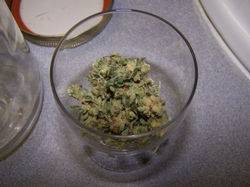
Razor blades and a shotglass...

...And a way to purge. In this case with heat, I use a cassarole dish lid, upside down, on top of a frying pan of boiling water, which is kept hot by an electric hotplate. Other methods are either on a seedling heat mat, or left out at room temperature, covered with a breathable lintless lid for a couple days. It takes a bit more time, but it turns out the same...
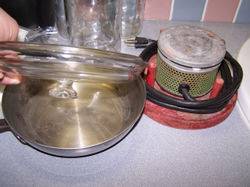
First things first, I like to make sure everything is clean, so I give everything a quick rinse with alcohol and hot water, and then let it all air dry...
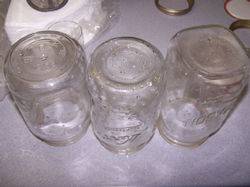
And then I get everything ready to go. A coffee filter placed in the top of one of the jars, and the strainer in the top of another jar, and a jar with a lid to do the wash in...

Roughly break up and dump the material into the wash jar, and fill the jar with enough alcohol to sufficiently cover(drown) all of the material. This is a very crucial part of the process where you have to be quick, as soon as the alcohol touches the material start counting...


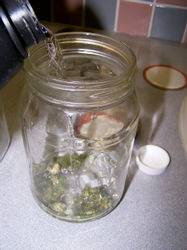

...Keep the exposure time of the alcohol and material around 30 seconds or less. I prefer 15-20 second washes myself. Reason being, any longer of an exposure dissolves alcohol soluble contams into the alcohol that will contaminate the final product, making it turn out runny and unpleasant to smoke.
As soon as you are nearing the last 10 seconds of your wash start to pour the alcohol and material through the strainer into the jar...


...I can't stress it enough, how much of a difference it makes to strain out the large pieces of material before filtering. Without straining before filtering, you are over exposing your material to the alcohol by allowing it all to sit in the filter, while waiting for it to filter.
After it has finished straining, immediately pour the strained alcohol into the jar with the filter in the top. You can now throw out the used material, or dry it out and do another run if you want to...



Shmike's QWISO Tutorial...
Please take the time to get to know your solvent before you expose yourself to it. Always use adequate ventilation, and always wash up after using Isopropyl Alcohol for extractions.
Isopropyl Alcohol Material Safety Data Sheet
------------------------------------------
------------------------------------------
NEW JERSEY DEPARTMENT OF HEALTH
Right to Know Program
CN 368, Trenton, NJ 08625 0368
------------------------------------------
------------------------------------------
Common Name: Isopropyl Alcohol
CAS Number: 67-63-0
DOT Number: UN 1219
Date: September, 1988
HAZARD SUMMARY
* Isopropyl Alcohol can affect you when breathed in and by
passing through your skin.
* There is an increased risk of cancer associated with the
manufacturing of Isopropyl Alcohol.
* Exposure can cause irritation of the eyes, nose, mouth, and
throat.
* Overexposure may cause headaches, drowsiness, clumsiness,
unconsciousness, and death.
* Contact may irritate the skin. Repeated skin exposure can
cause itching, a rash, and drying and cracking.
* Isopropyl Alcohol is a FLAMMABLE LIQUID and a FIRE HAZARD.
REASON FOR CITATION
* Isopropyl Alcohol is on the Hazardous Substance List because
it is regulated by OSHA(Occupational Safety and Health
Administration) and cited by ACGIH(American Conference of
Industrial Hygienists), DOT, NFPA(National Fire Protection Agency)
and EPA(Environmental Protection Agency).
* This chemical is on the Special Health Hazard Substance List
because it is FLAMMABLE.
HOW TO DETERMINE IF YOU ARE BEING EXPOSED
* ODOR THRESHOLD = 22 ppm.
* The odor threshold only serves as a warning of exposure. Not
smelling it does not mean you are not being exposed.
WORKPLACE EXPOSURE LIMITS
OSHA: The legal airborne permissible exposure limit (PEL) is
400 ppm averaged over an 8 hour workshift.
NIOSH: The recommended airborne exposure limit is 400 ppm
averaged over a 10 hour workshift and 800 ppm, not to be
exceeded during any 15 minute work period.
ACGIH: The recommended airborne exposure limit is 400 ppm
averaged over an 8 hour workshift and 500 ppm as a STEL
(short term exposure limit).
* The above exposure limits are for air levels only. When skin
contact also occurs, you may be overexposed, even though air
levels are less than the limits listed above.
WAYS OF REDUCING EXPOSURE
* Wash thoroughly immediately after exposure to Isopropyl
Alcohol and at the end of the workshift/making an extract.
This Fact Sheet is a summary source of information of all potential
and most severe health hazards that may result from exposure.
Duration of exposure, concentration of the substance and other
factors will affect your susceptibility to any of the potential
effects described below.
------------------------------------------
HEALTH HAZARD INFORMATION
Acute Health Effects
The following acute (short term) health effects may occur
immediately or shortly after exposure to Isopropyl Alcohol:
* It may irritate the skin, causing a rash or burning feeling on
contact.
* Exposure can irritate the eyes, nose, and throat.
* Overexposure to the vapor may cause headaches, drowsiness, a
loss of coordination, collapse, and death.
Chronic Health Effects
The following chronic (long term) health effects can occur at some
time after exposure to Isopropyl Alcohol and can last for months or
years:
Cancer Hazard
* There is an increased incidence of nasal sinus cancer in
workers involved in the manufacture of Isopropyl Alcohol by
the strong acid process. There is no evidence that Isopropyl
Alcohol is a carcinogen.
Reproductive Hazard
* According to the information presently available to the New
Jersey Department of Health, Isopropyl Alcohol has not been
tested for its ability to adversely affect reproduction.
Other Long Term Effects
* Skin exposure can cause itching, redness, and rashes in some
people. Repeated or prolonged exposure can cause dryness and
cracking of skin.
* This chemical has not been adequately evaluated to determine
whether brain or other nerve damage could occur with repeated
exposure. However, many solvents and other petroleum based
chemicals have been shown to cause such damage. Effects may
include reduced memory and concentration, personality changes
(withdrawal, irritability), fatigue, sleep disturbances,
reduced coordination, and/or effects on nerves supplying
internal organs (autonomic nerves) and/or nerves to the arms
and legs (weakness, "pins and needles").
HANDLING AND STORAGE
* Prior to working with Isopropyl Alcohol you should be trained
on its proper handling and storage.
* Isopropyl Alcohol must be stored to avoid contact with STRONG
OXIDIZERS (such as CHLORINE, BROMINE, and FLUORINE) since
violent reactions occur.
* Store in tightly closed containers in a cool, well ventilated
area away from HEAT.
* Sources of ignition, such as smoking and open flames, are
prohibited where Isopropyl Alcohol is used, handled, or stored
in a manner that could create a potential fire or explosion
hazard.
Common Name: Isopropyl Alcohol
DOT Number: UN 1219
DOT Emergency Guide code: 26
CAS Number: 67-63-0
----------------------------------------
Hazard rating NJ DOH NFPA
FLAMMABILITY - 3
REACTIVITY - 0
----------------------------------------
POISONOUS GASES ARE PRODUCED IN FIRE
CONTAINERS MAY EXPLODE IN FIRE
----------------------------------------
Hazard Rating Key: 0=minimal; 1=slight; 2=moderate; 3=serious;
4=severe
FIRE HAZARDS
* Isopropyl Alcohol is a FLAMMABLE LIQUID.
* Vapors may travel to a source of ignition and flash back.
* CONTAINERS MAY EXPLODE IN FIRE.
* Use dry chemical, CO2, water spray, or alcohol foam
extinguishers.
* POISONOUS GASES ARE PRODUCED IN FIRE.
FIRST AID
POISON INFORMATION
Eye Contact
* Immediately flush with large amounts of water for at least 15
minutes, occasionally lifting upper and lower lids.
Skin Contact
* Quickly remove contaminated clothing. Immediately wash
contaminated skin with large amounts of water.
Breathing
* Remove the person from exposure.
* Begin rescue breathing if breathing has stopped and CPR if
heart action has stopped.
* Transfer promptly to a medical facility.
PHYSICAL DATA
Vapor Pressure: 33 mm Hg at 68oF (20oC)
Flash Point: 53oF (11.6oC)
Water Solubility: Miscible
OTHER COMMONLY USED NAMES
Chemical Name:
2-Propanol
Other Names and Formulations:
Rubbing Alcohol; Dimethylcarbinol; Isopro panol; sec-Propyl
Alcohol.
ECOLOGICAL INFORMATION
Isopropyl alcohol is a clear, flammable liquid with numerous uses.
It is used in antifreeze; as a solvent for gums, shellac and
essential oils; in quick-drying inks and oils; in cosmetics such as
body rubs, hand lotions and after-shave lotions; and to make other
chemicals. It may enter the environment from industrial
discharges, municipal waste water treatment discharges, or spills.
WATER SOLUBILITY
Isopropyl alcohol is highly soluble in water. Concentrations of
1,000 milligrams and more will mix with a liter of water.
DISTRIBUTION AND PERSISTENCE IN THE ENVIRONMENT
Isopropyl alcohol is slightly persistent in water, with a half-life
of between 2 to 20 days. The half-life of a pollutant is the
amount of time it takes for one-half of the chemical to be
degraded. About 77.5% of isopropyl alchohol will eventually end up
in water; the rest will end up in the air.
Molecular Weight: 60.11 g/mole
Molecular Formula: C3-H8-O
Boiling/Condensation Point: 82.55*C (180.6*F)
Melting/Freezing Point: -88.83*C (-127.9*F)
Specific Gravity: 0.785 (Water: 1)
Vapor Density: 2.07 (Air: 1)
Things you'll need:
Alcohol (Isopropyl/Isopropanol 99%,91%,70%. The lower the percent of Alcohol to distilled water, the longer it will take to purge) Rubbing alcohol is unusable, it contains dyes, perfumes, and denaturants that will contaminate your concentrate...
(50ml/g - alcohol/weed(gram))

Clean jars w/ lids...

Coffee filters and a stainless steel strainer...


Material(Weed)...

Razor blades and a shotglass...

...And a way to purge. In this case with heat, I use a cassarole dish lid, upside down, on top of a frying pan of boiling water, which is kept hot by an electric hotplate. Other methods are either on a seedling heat mat, or left out at room temperature, covered with a breathable lintless lid for a couple days. It takes a bit more time, but it turns out the same...

First things first, I like to make sure everything is clean, so I give everything a quick rinse with alcohol and hot water, and then let it all air dry...

And then I get everything ready to go. A coffee filter placed in the top of one of the jars, and the strainer in the top of another jar, and a jar with a lid to do the wash in...

Roughly break up and dump the material into the wash jar, and fill the jar with enough alcohol to sufficiently cover(drown) all of the material. This is a very crucial part of the process where you have to be quick, as soon as the alcohol touches the material start counting...




...Keep the exposure time of the alcohol and material around 30 seconds or less. I prefer 15-20 second washes myself. Reason being, any longer of an exposure dissolves alcohol soluble contams into the alcohol that will contaminate the final product, making it turn out runny and unpleasant to smoke.
As soon as you are nearing the last 10 seconds of your wash start to pour the alcohol and material through the strainer into the jar...


...I can't stress it enough, how much of a difference it makes to strain out the large pieces of material before filtering. Without straining before filtering, you are over exposing your material to the alcohol by allowing it all to sit in the filter, while waiting for it to filter.
After it has finished straining, immediately pour the strained alcohol into the jar with the filter in the top. You can now throw out the used material, or dry it out and do another run if you want to...



Last edited:
S
Shmike
So now we're past the wash and strain part, and are now waiting for the alcohol to finish filtering.
I find the coffee filters clog up fast with the fine pieces of material that make it past the strainer. So when I notice the alcohol starting to filter slowly, I swap the filter for a new one, by raising the clogged one up out of the jar, and placing a new coffee filter underneath it; then pouring the remaining unfiltered alcohol into the new coffee filter, out of the old clogged coffee filter...


After everything has finished filtering, take the coffee filter out of the top of the jar and put a lid on the jar of filtered alcohol. After the alcohol has been filtered you are in no hurry to purge the alcohol away, it could sit in a cool dark place for a month and still turn out like it was all made that day...


Here's a clogged filter that I swapped for a new one...
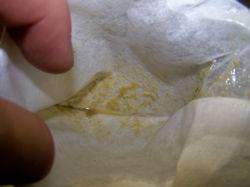
So, onto the purge, which should be done either outside or in a ridiculously well ventilated area, you don't want to be breathing this stuff in. Keep a tight fitting lid close by to smother the flames just in case the alcohol does ignite somehow. I get my hotplate warmed up and I pre-boil my water in an electric kettle before I pour it into the frying pan. Then I place the casserole dish lid on top of the frying pan of boiling water. I then let it sit and let it all warm up...

 (Excuse the dirty finger I started tinkering on an engine when I was waiting for the plate to warm up.
(Excuse the dirty finger I started tinkering on an engine when I was waiting for the plate to warm up. )
)
With the boiling water keeping the dish at a steady temperature of around 90-97*C, The dish never gets too hot to touch. You have to keep an eye on the water level and top it up during bigger batches, when done this way.
After it's all ready to go, pour on the alcohol and stand back...
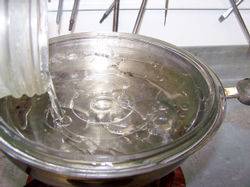
After around 20-30 minutes check on it, you'll be able to tell when all of the alcohol is gone when the oil cannot be moved around the dish by tipping it or blowing it around...

If it is ready, let it sit for another minute before collecting it all up with the razor blades, and you should be left with an oily substance that looks like this and hardens into a rock candy like consistency after a few seconds.
For oil that has been purged over a heat pad or at room temperature, when it looks ready, I would suggest putting your dish of oil over top of a pot of boiling water for a couple minutes just to make sure. It'll also make it easier to get the oil off of the dish...
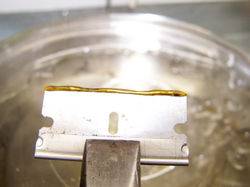





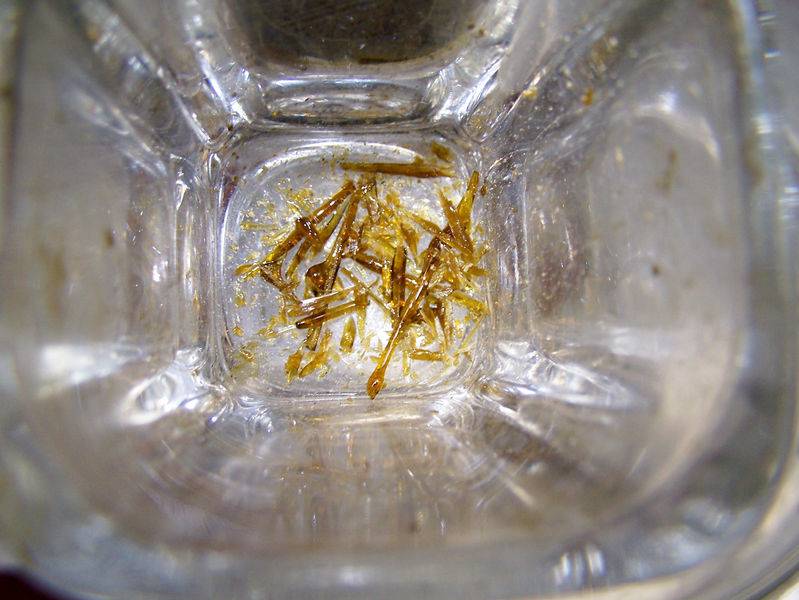
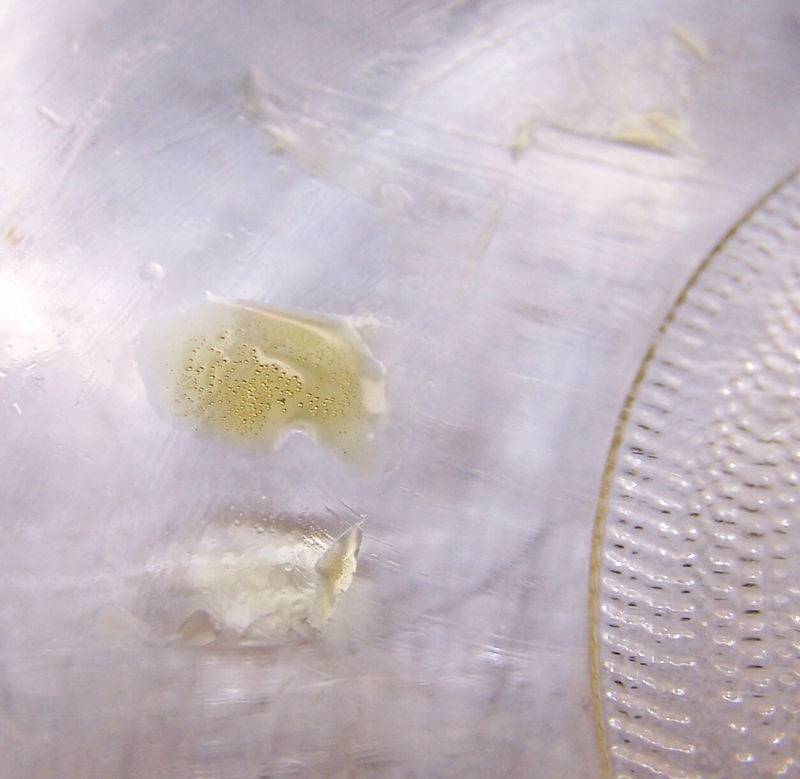
I find the coffee filters clog up fast with the fine pieces of material that make it past the strainer. So when I notice the alcohol starting to filter slowly, I swap the filter for a new one, by raising the clogged one up out of the jar, and placing a new coffee filter underneath it; then pouring the remaining unfiltered alcohol into the new coffee filter, out of the old clogged coffee filter...


After everything has finished filtering, take the coffee filter out of the top of the jar and put a lid on the jar of filtered alcohol. After the alcohol has been filtered you are in no hurry to purge the alcohol away, it could sit in a cool dark place for a month and still turn out like it was all made that day...


Here's a clogged filter that I swapped for a new one...

So, onto the purge, which should be done either outside or in a ridiculously well ventilated area, you don't want to be breathing this stuff in. Keep a tight fitting lid close by to smother the flames just in case the alcohol does ignite somehow. I get my hotplate warmed up and I pre-boil my water in an electric kettle before I pour it into the frying pan. Then I place the casserole dish lid on top of the frying pan of boiling water. I then let it sit and let it all warm up...

 (Excuse the dirty finger I started tinkering on an engine when I was waiting for the plate to warm up.
(Excuse the dirty finger I started tinkering on an engine when I was waiting for the plate to warm up.With the boiling water keeping the dish at a steady temperature of around 90-97*C, The dish never gets too hot to touch. You have to keep an eye on the water level and top it up during bigger batches, when done this way.
After it's all ready to go, pour on the alcohol and stand back...

After around 20-30 minutes check on it, you'll be able to tell when all of the alcohol is gone when the oil cannot be moved around the dish by tipping it or blowing it around...

If it is ready, let it sit for another minute before collecting it all up with the razor blades, and you should be left with an oily substance that looks like this and hardens into a rock candy like consistency after a few seconds.
For oil that has been purged over a heat pad or at room temperature, when it looks ready, I would suggest putting your dish of oil over top of a pot of boiling water for a couple minutes just to make sure. It'll also make it easier to get the oil off of the dish...








Last edited:
G
Guest
do freeze the oil on the razor before you collect it in the shot glass. I live in a hot climate. I have to keep the oil in the freezer.
R00KIE
Active member
Woooot!!!! 
Welcome back Bro!!!
Hope everything turned out fine.
What a relief man, was startin to think something ill happened, but your back so it must not have been tooo bad...
Stupid question, but where do you find big bottles of iso, and are you using isopropanol or isopropyl alchohol??
Welcome back Shmike!

Welcome back Bro!!!

Hope everything turned out fine.
What a relief man, was startin to think something ill happened, but your back so it must not have been tooo bad...
Stupid question, but where do you find big bottles of iso, and are you using isopropanol or isopropyl alchohol??
Welcome back Shmike!
S
Shmike
Hey R00KIE! I'm glad to be back. Thanks for the welcome dude!
I'm glad to be back. Thanks for the welcome dude! 

I get those jugs of alcohol from a local hydroponic store. They have jugs of 99% isopropanol alcohol in 1L, 4L, and 20L jugs; and in 50 gallon barrels. I just get a few 4L jugs at a time. The guy that runs the shop says it comes from a local lab and is the same stuff the hospital uses. I just like the fact that I do not have to buy a dozen little bottles at a time from a pharmacy lol.
As for Isopropyl/Isopropanol, they're both the same thing, I can't remember if it's a language thing or what; but isopropanol alcohol is isopropyl alcohol, and isopropyl alcohol is isopropanol alcohol.
I got way too high and forgot the last part of the tutorial...
...Enjoy!
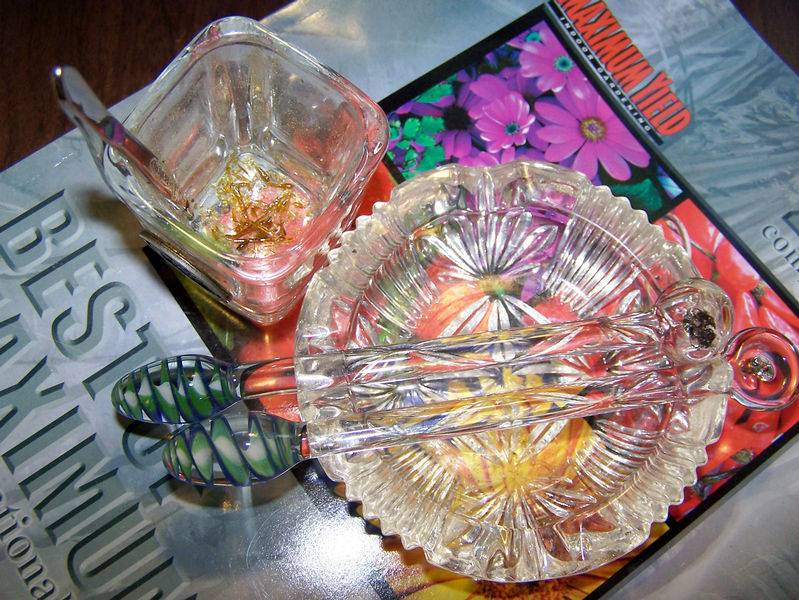
 I'm glad to be back. Thanks for the welcome dude!
I'm glad to be back. Thanks for the welcome dude! 
I get those jugs of alcohol from a local hydroponic store. They have jugs of 99% isopropanol alcohol in 1L, 4L, and 20L jugs; and in 50 gallon barrels. I just get a few 4L jugs at a time. The guy that runs the shop says it comes from a local lab and is the same stuff the hospital uses. I just like the fact that I do not have to buy a dozen little bottles at a time from a pharmacy lol.
As for Isopropyl/Isopropanol, they're both the same thing, I can't remember if it's a language thing or what; but isopropanol alcohol is isopropyl alcohol, and isopropyl alcohol is isopropanol alcohol.
In a hot climate I'd imagine oil hot off of the dish would probably not want to harden like it does for me, or atleast stay that way out in the open. My oil hardens pretty much right after being scraped off of the dish, and when I scrape the oil off of the razor into the shotglass is just shatters. I can pick it up with my fingers and hold it for around 10 seconds before it becomes sticky and moldable from the warmth of my hands. For storage in a hot climate, if that's the best method to store it in the freezer, then do what ya gotta do. Freezing the oil to get it off of the razor blade would probably help alot also.Gringo said:do freeze the oil on the razor before you collect it in the shot glass. I live in a hot climate. I have to keep the oil in the freezer.
I got way too high and forgot the last part of the tutorial...
...Enjoy!


Last edited:
its kurmit
Member
welcome back shmike! good to hear all is well







